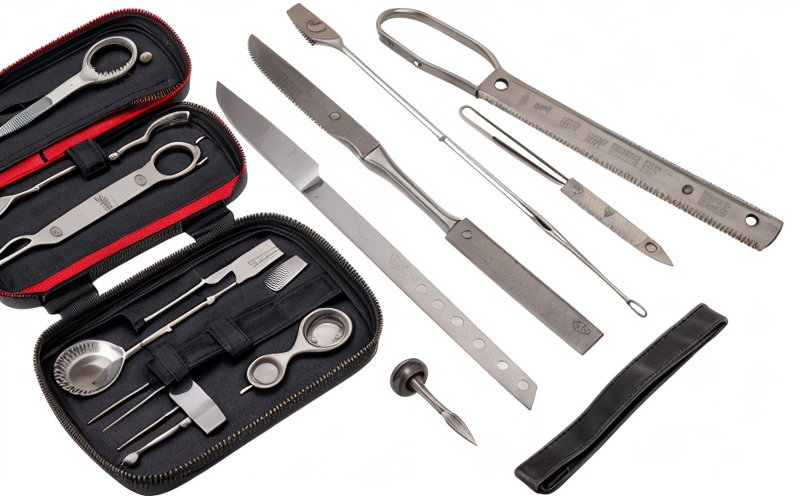Material Fatigue Testing in High Cycle Use Instruments
In the realm of medical device testing, particularly within surgical instruments and tools, material fatigue testing is an essential process. This testing ensures that devices designed for high cycle use endure repeated stress without failing or compromising patient safety.
Material fatigue refers to the gradual reduction in strength and integrity of materials due to cyclic loading over time. High cycle use surgical instruments are subjected to repetitive stresses during their operational life, making them particularly vulnerable to fatigue-induced failure. This can lead to device malfunctions, which may result in significant harm or even death.
The importance of this testing is underscored by the stringent regulatory requirements imposed by bodies such as the Food and Drug Administration (FDA) and ISO 10993. Compliance with these standards not only ensures patient safety but also protects manufacturers from potential legal liabilities.
During material fatigue testing, specimens are subjected to a predefined number of cycles under controlled conditions that mimic real-world usage patterns. The primary goal is to determine the cyclic loading limit beyond which the material begins to exhibit signs of wear and tear or failure.
The process involves several critical steps: first, selecting the appropriate specimen size and shape; second, calibrating test equipment to ensure accuracy; third, applying a consistent load pattern that replicates actual usage conditions; fourth, monitoring for any indications of fatigue such as cracks or deformation; finally, analyzing data to derive meaningful conclusions about material integrity.
Understanding the specifics of this testing requires knowledge of various factors including cyclic stress amplitude, frequency, and duration. For instance, surgical instruments that are used frequently in high-risk procedures like joint replacements may require higher cycle counts compared to those used less often for minor surgeries.
The methodology employed in this testing aligns closely with international standards such as ISO 10993-6, which provides comprehensive guidelines on how to conduct fatigue tests. Compliance with these standards ensures that the results of your testing are reliable and can be trusted by regulatory authorities worldwide.
Proper specimen preparation is crucial for accurate results. Specimens must be cut from representative areas of the instrument where stress concentrations occur most frequently, ensuring they reflect real-world conditions accurately. Calibration of test machines guarantees precise application of cyclic loads, while continuous monitoring allows early detection of fatigue symptoms before significant damage occurs.
This testing process is not only vital for new product development but also plays a crucial role in ongoing quality assurance programs. By regularly subjecting existing products to fatigue tests, manufacturers can identify potential issues early on and implement corrective measures promptly.
Scope and Methodology
The scope of material fatigue testing encompasses the evaluation of materials used in surgical instruments designed for high cycle use. This includes identifying the optimal specimen sizes and shapes, calibrating test equipment accurately, applying consistent cyclic loading patterns, monitoring for signs of fatigue such as cracks or deformations, and analyzing data to draw conclusions about material integrity.
The methodology involves selecting specimens cut from representative areas where stress concentrations occur most frequently. These specimens are then subjected to a predefined number of cycles under controlled conditions that replicate actual usage scenarios. Continuous monitoring ensures early detection of fatigue symptoms before significant damage occurs.
Calibration of test machines is essential for precise application of cyclic loads, ensuring accurate results. Compliance with international standards like ISO 10993-6 guarantees reliable and trusted outcomes that can be accepted by regulatory authorities globally.
- Specimen preparation involves cutting from areas prone to stress concentration.
- Calibration of test equipment ensures accurate application of cyclic loads.
- Continuous monitoring detects fatigue symptoms early.
Industry Applications
Material fatigue testing finds extensive applications across various sectors, particularly in industries where high cycle use devices are critical. One such industry is medical device manufacturing, where surgical instruments like drills and saws undergo rigorous fatigue tests to ensure their reliability.
- Bone fracture fixation devices
- Joint replacement implants
- Dental tools
- Catheterization equipment
- Endoscopic instruments
Use Cases and Application Examples
In the field of orthopedics, for instance, drills used in hip replacements experience high levels of cyclic loading. These tools must withstand repeated impacts without failing, making fatigue testing indispensable.
A similar scenario arises with endoscopic instruments employed during minimally invasive surgeries. These devices are inserted through small incisions and maneuvered to access hard-to-reach areas within the body. They too face significant cyclic stresses necessitating thorough fatigue evaluation.





